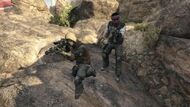The Ignacian Militia, sometimes abbreviated ID, was a militant force from the Expansion Region planet of Ignacia. Led by Field Marshal Hugo Kliest, the militia originally started out sometime prior to 25,060 BBY as a group of mercenaries and hired thugs, as well some poorly trained and armed Ignacian natives. It was directly commanded by the Field Marshal, who appointed a High General as a second—in—command. They did not have a political ideology, and were trying to fill the power vacuum caused by the collapse of the Infinite Empire, like the other factions of the Unification Wars.
History[]
As the galaxy-spanning Infinite Empire collapsed, and the Rakatans retreated back to their home planet of Lehon, various factions arose from the ruins of the former Empire. One of those was the Ignacian Militia, which was created by Hugo Kliest, a former Rakatan slave. He was very intelligent, having been sent to work for senior Rakatan officials on Lehon itself. Kliest returned and started his own military force in order to conquer his home planet. He did so successfully, largely due to lack of challengers. Many offworlders, such as mercenaries and criminals, were in his forces, which raised the rates of corruption and crime.

Militiamen target practicing.
As the Militia rose to prominence, Kliest drafted many more native Ignacians into it, while kicking out the criminal elements. Mercenaries stayed to train the new conscripts. The ones who stood out were given further training (very little) to be officers. Kliest came into possession of former Rakatan warships, which he used to subjugate the system. The Militia navy had skirmishes with the Outer Rim Confederation, as well as other factions. As the Unification Wars broke out, he used the fleet to quickly spread to other planets.
Politics[]
The Militia did not have an official government, led by the Field Marshal and his High General. Other officers were not given as much power, and constantly tried to obtain more power by working amongst themselves. The High General was appointed by Kliest from among the officers if they showed exceptional loyalty and skill. Often officers would attempt to fake incidents in order to make themselves look better in his view, or would discredit their fellow officers.
Lower ranking members, such as enlisted and drafted militiamen, and non-commissioned officers, had almost no control over the affairs of the Militia. The officers, in turn, treated troops poorly most of the time, though a few individuals did stand out as good commanders. Officers viewed troops as little more than servants and often sent them on kamikaze attacks.
The Militia opposed all other factions, viewing them to be oppressors.
Tactics[]
In the early days, guerrilla tactics were used, but as more joined (or were forced into it), human wave attacks were used. Many officers had troops strap on explosives and fight from a vantage point. Upon nearing defeat, they would detonate themselves to kill more enemies. Armored units were in low amount, as vehicles were hard to come by even as soldiers were not. As a result, many battle tactics were based on defense of the vehicles as they fired from a distance.
Funding[]
Ignacia had few natural resources for the Militia to sell or use for themselves, making maintaining an economy difficult at best, so other ways of gaining funds were thought of. The Marshal often had teams capture random offworlders and ask for money or goods in return for them. Officers were known to sell equipment to other factions and sometimes even hired out entire units as mercenaries. Kliest was also a known pimp, selling women into sex slavery.
Units[]
The structure of the Militia was inefficient, and often times, hard to understand. That was the severe disadvantage the Militia had throughout the a Unification a Wars; lack of proper organization, with some officers attacking too soon or too late in battle and resulting in a defeat. This also contributed to the high casualty rates of Militia forces, though poor training and inadequate equipment was the primary cause. Each commander possessed his/her own militia unit, which they ran as they pleased.
Volksmilitia[]
One of the primary unit, the Volksmilitia was composed of several thousand troops and was under direct command of the Marshal, and sometimes the High General. Soldiers of it were known to be the best trained and most experienced, as well as most adequately armed. It saw a lot of action during the War, often aiding smaller units.
